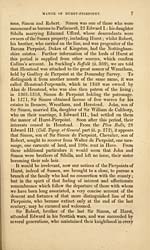Notices of the Ellises of England, Scotland, and Ireland, from the conquest to the present time
(376) Page 372
Download files
Complete book:
Individual page:
Thumbnail gallery: Grid view | List view

8 MANOR OP HURST-PIERPOINT.
reign, till in the time of Charles I., Robert Pierpoint was
raised to the peerage, by the titles of Baron Pierrepoint,
Viscount Newark, and Earl of Kingston-upon-Hull, whose
son obtained the further dignity of Marquis of Dorchester.
This last title, however, became extinct in the person of its
first occupant, he dying without male issue. The other titles
passed to his male heir, in whose successor Evelyn Pierrepoint,
1706, the marquisate of Dorchester was revived, and who
in 1715 was advanced to the highest grade in the peerage,
by being created Duke of Kingston. This and all the other
hereditary dignities, however, became extinct with the death
of Evelyn Pierrepoint, grandson of the first Duke, in 1773.
But the name of Pierrepoint and some of the titles were
subsequently revived. Charles Meadows, being son of Philip
Meadows, by Frances, sister and heir of Evelyn, last Duke of
Kingston, assumed the name of Pierrepoint, and was created
Baron Pierrepoint of Holme-Pierrepoint, and Viscount Newark,
1796 ; and Earl Manvers, 1816, ancestor of the present Earl
Manvers, &c.
Before we proceed to notice the successors of the Pier-
points, we may well pause to indulge in a few observations on
a race who for so many generations occupied a foremost rank
among those proud and potent vassals of a long feudal and
warlike period, those Anglo-Norman Sussex knights and
warriors — the Echinghams and St. Legers, the Poynings'
and Kaynes', the Savages and Percys and Bohuns. Whe-
ther one race is really more prolific than another — not within
the narrow limits of a county and a century, but compre-
hending all the male descendants in a direct line of some one
progenitor for four or five centuries — would be a curious
genealogical inquiry, and not without much ethnological and
physiological interest. But certainly there are families who
flourish so numerously for a few generations in certain dis-
tricts, and then almost entirely disappear, as if struck down
root and branch by some curse or plague ; whilst others never
cease from the land, but, pushing deep and wide their roots,
keep up their numbers with unfailing fertility on their native
soil. There were Chatfields and Luxfords and Cruttendens,
in Sussex 500 years ago; and there are probably as many
Chatfields and Luxfords and Cruttendens in the county now,
reign, till in the time of Charles I., Robert Pierpoint was
raised to the peerage, by the titles of Baron Pierrepoint,
Viscount Newark, and Earl of Kingston-upon-Hull, whose
son obtained the further dignity of Marquis of Dorchester.
This last title, however, became extinct in the person of its
first occupant, he dying without male issue. The other titles
passed to his male heir, in whose successor Evelyn Pierrepoint,
1706, the marquisate of Dorchester was revived, and who
in 1715 was advanced to the highest grade in the peerage,
by being created Duke of Kingston. This and all the other
hereditary dignities, however, became extinct with the death
of Evelyn Pierrepoint, grandson of the first Duke, in 1773.
But the name of Pierrepoint and some of the titles were
subsequently revived. Charles Meadows, being son of Philip
Meadows, by Frances, sister and heir of Evelyn, last Duke of
Kingston, assumed the name of Pierrepoint, and was created
Baron Pierrepoint of Holme-Pierrepoint, and Viscount Newark,
1796 ; and Earl Manvers, 1816, ancestor of the present Earl
Manvers, &c.
Before we proceed to notice the successors of the Pier-
points, we may well pause to indulge in a few observations on
a race who for so many generations occupied a foremost rank
among those proud and potent vassals of a long feudal and
warlike period, those Anglo-Norman Sussex knights and
warriors — the Echinghams and St. Legers, the Poynings'
and Kaynes', the Savages and Percys and Bohuns. Whe-
ther one race is really more prolific than another — not within
the narrow limits of a county and a century, but compre-
hending all the male descendants in a direct line of some one
progenitor for four or five centuries — would be a curious
genealogical inquiry, and not without much ethnological and
physiological interest. But certainly there are families who
flourish so numerously for a few generations in certain dis-
tricts, and then almost entirely disappear, as if struck down
root and branch by some curse or plague ; whilst others never
cease from the land, but, pushing deep and wide their roots,
keep up their numbers with unfailing fertility on their native
soil. There were Chatfields and Luxfords and Cruttendens,
in Sussex 500 years ago; and there are probably as many
Chatfields and Luxfords and Cruttendens in the county now,
Set display mode to:
![]() Universal Viewer |
Universal Viewer | ![]() Mirador |
Large image | Transcription
Mirador |
Large image | Transcription
Images and transcriptions on this page, including medium image downloads, may be used under the Creative Commons Attribution 4.0 International Licence unless otherwise stated. ![]()
| Histories of Scottish families > Notices of the Ellises of England, Scotland, and Ireland, from the conquest to the present time > (376) Page 372 |
|---|
| Permanent URL | https://digital.nls.uk/95550125 |
|---|
| Description | A selection of almost 400 printed items relating to the history of Scottish families, mostly dating from the 19th and early 20th centuries. Includes memoirs, genealogies and clan histories, with a few produced by emigrant families. The earliest family history goes back to AD 916. |
|---|

